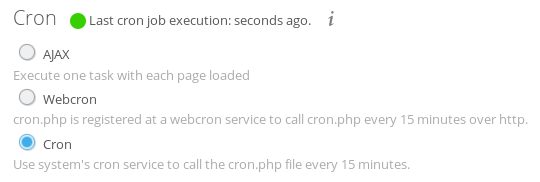Nextcloud
Prerequisite
Install
Download
Download Nextcloud from https://nextcloud.com/install/#instructions-server and extract the archive in /var/www/nextcloud.
Fix file permissions using
$ sudo chown -r www-data: /var/www/nextcloud/
Configure PHP
Edit file /etc/php/7.0/mods-available/local-common.ini and add /var/www/nextcloud/:/dev/:/var/log/nextcloud/ to the open_basedir setting.
Reload PHP:
$ sudo systemctl reload php7.0-fpm.service
Configure Webserver
- Create the config file
/etc/nginx/sites-available/nextcloud.example.orgserver { include snippets/listen-http.conf; server_name nextcloud.example.org; access_log /var/log/nginx/nextcloud.example.org.access.log; error_log /var/log/nginx/nextcloud.example.org.error.log; include snippets/https-permanent-redirect.conf; } server { include snippets/listen-https.conf; server_name nextcloud.example.org; access_log /var/log/nginx/nextcloud.example.org.access.log; error_log /var/log/nginx/nextcloud.example.org.error.log; include snippets/acme-challenge.conf; #include snippets/ssl.conf; #ssl_certificate /etc/letsencrypt/live/nextcloud.example.org/fullchain.pem; #ssl_certificate_key /etc/letsencrypt/live/nextcloud.example.org/privkey.pem; #include snippets/hsts.conf; # Protect web interface during initial setup # The following two lines must be removed after initial configuration auth_basic "You shall not pass!"; auth_basic_user_file /etc/nginx/htpasswd/generic.htpasswd; include snippets/security-headers.conf; # Using more_set_headers instead of add_header to be cascaded in sub location more_set_headers "X-Robots-Tag: none"; more_set_headers "X-Download-Options: noopen"; # Path to the root of your installation root /var/www/nextcloud/; location = /.well-known/carddav { return 301 $scheme://$host/remote.php/dav; } location = /.well-known/caldav { return 301 $scheme://$host/remote.php/dav; } client_max_body_size 10G; # set max upload size fastcgi_buffers 64 4K; location / { rewrite ^ /index.php$uri; } location ~ ^/(?:build|tests|config|lib|3rdparty|templates|data)/ { deny all; } location ~ ^/(?:\.|autotest|occ|issue|indie|db_|console) { deny all; } location ~ ^/(?:index|remote|public|cron|core/ajax/update|status|ocs/v[12]|updater/.+|ocs-provider/.+)\.php(?:$|/) { fastcgi_split_path_info ^(.+\.php)(/.+)$; include fastcgi_params; fastcgi_param SCRIPT_FILENAME $document_root$fastcgi_script_name; fastcgi_param PATH_INFO $fastcgi_path_info; fastcgi_param HTTPS on; fastcgi_param modHeadersAvailable true; #Avoid sending the security headers twice fastcgi_param front_controller_active true; fastcgi_pass php; fastcgi_intercept_errors on; fastcgi_request_buffering off; } location ~ ^/(?:updater|ocs-provider)(?:$|/) { try_files $uri/ =404; index index.php; } # Adding the cache control header for js and css files # Make sure it is BELOW the PHP block location ~* \.(?:css|js|woff|svg|gif)$ { try_files $uri /index.php$uri$is_args$args; add_header Cache-Control "public, max-age=15778463"; } location ~* \.(?:png|html|ttf|ico|jpg|jpeg)$ { try_files $uri /index.php$uri$is_args$args; } }
- Activate the configuration with
$ sudo nginx_modsite -e nextcloud.example.org Would you like to reload the Nginx configuration now? (Y/n) Y
- Edit file
/usr/local/etc/certmanage/main.jsonand add the following to the list{ "domains": ["nextcloud.example.org"], "reload": [["/bin/systemctl", "reload", "nginx.service"]] }
- Get your certificate
$ sudo /usr/local/sbin/certmanage Renewing certificate for nextcloud.example.org that will expire on 0001-01-01 Saving debug log to /var/log/letsencrypt/letsencrypt.log Starting new HTTPS connection (1): acme-v01.api.letsencrypt.org Obtaining a new certificate Performing the following challenges: http-01 challenge for nextcloud.example.org Using the webroot path /var/www/acme-challenge for all unmatched domains. Waiting for verification... Cleaning up challenges Generating key (2048 bits): /etc/letsencrypt/keys/1764_key-certbot.pem Creating CSR: /etc/letsencrypt/csr/1764_csr-certbot.pem IMPORTANT NOTES: - Congratulations! Your certificate and chain have been saved at /etc/letsencrypt/live/nextcloud.example.org/fullchain.pem. Your cert will expire on 2024-07-22. To obtain a new or tweaked version of this certificate in the future, simply run certbot again. To non-interactively renew *all* of your certificates, run "certbot renew" - If you like Certbot, please consider supporting our work by: Donating to ISRG / Let's Encrypt: https://letsencrypt.org/donate Donating to EFF: https://eff.org/donate-le Restarting services: systemctl reload nginx.service
- Uncomment the ssl related lines in
/etc/nginx/sites-available/nextcloud.example.organd run$ sudo systemctl reload nginx.service
Configure Nextcloud
//config.php
$ sudo tee "/usr/local/bin/occ" > /dev/null << EOF
> !/bin/sh
> sudo -u www-data /usr/bin/php /var/www/nextcloud/occ "\$@"
> EOF
$ sudo chmod +x /usr/local/bin/occ
Logs
First you need to create a folder for the logs
$ sudo mkdir /var/log/nextcloud
$ sudo chmod 750 /var/log/nextcloud
$ sudo chown www-data:adm /var/log/nextcloud
Create file /etc/logrotate.d/nextcloud with the following content
/var/log/nextcloud/nextcloud.log {
rotate 6
monthly
compress
delaycompress
missingok
notifempty
create 640 www-data adm
}
Finally activate the new log location. Edit /var/www/nextcloud/config/config.php and add/edit the logfile line
'logfile' => '/var/log/nextcloud/nextcloud.log',
Cron
Create file /etc/cron.d/nextcloud
*/15 * * * * www-data /usr/bin/php -f /var/www/nextcloud/cron.php
Now open Nextcloud in your browser and go to the admin section and activate cron
Test
Security
Nextcloud is providing a security scanning service for public instances. Scan your instance to find configuration issues.
